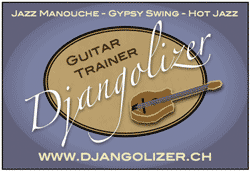
10 - Scales
Here you learn about the three most important scales in Gypsy Swing. Practice them carefully and you will feel free while improvising.These scales are…
- Major scale with it's church modes
- Harmonic minor
- Wholetone scale
- Harmonic minor
- Wholetone scale
Of course you have many more scales in Djangolizer. Probably, some of them are played rather in American Jazz, than in Gypsy Swing. But check them out anyway, to get inspired by their sound.
It can be quite a challenge, to bring out the harmonies of the song with just playing scales. A solution could be, to start or land on chord notes (arpeggio).
Activate in Djangolizer the arpeggio view in addition to the scale view.
The Major Scale
The mother of all scales is the major scale (All nursery rhyme are chanted in major!).What will happen, when you play this major scale, but starting from another note than the root note? You will get another scale, which can be minor or major, depending on the interval of the third note. With seven different starting notes, you will get seven different scales with different moods. Each one of these scales got a name and all together they're called Church modes. Usually they're enumerated with Roman numerals…
The seven church modes
I. Ionian (major 3rd -> major scale)II. Dorian (minor 3rd -> minor scale)
III. Phrygian (minor 3rd -> minor scale)
IV. Lydian (major 3rd -> major scale)
V. Mixolydian (major 3rd and a minor 7th -> dominant scale)
VI. Aeolian (minor 3rd -> minor scale)
VII. Locrian (minor 3rd and b5 -> Halfdiminished)
For example: All seven church modes, when the tonality is in C major
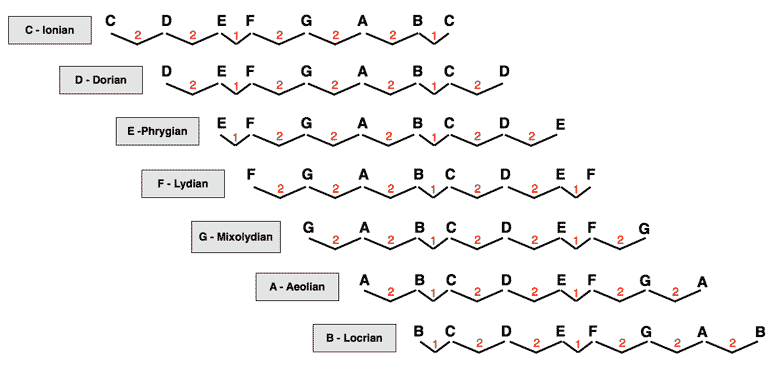
As you can see on the fretboard view: All four scales have the same notes (note view), but, obviously, their root notes are on different places (interval view).
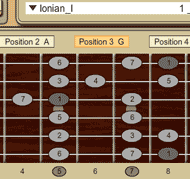
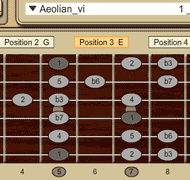
For example: At left the C major scale (Ionian), at right the A minor scale (Aeolian)
Practice the most important church modes: Ionian, Aeolian, Dorian and Mixolydian in all five positions.
Swing 42 (Rhythm Change in C major)
The theme of Swing 42 starts with the G Mixolydian scale.
IIm-V7-I lick in C major
Here a simple example, how you could improvise with these scales over a IIm-V7-I.
Djangolizer Power-User
Practice those scales over the exercise "Ex - Major 2-5-1 Quart Circle…" from the Djangolizer song library.Start with 2-5-1 in C major. After mastering that, practice it in the other eleven tonalities as well (or at least those you need daily). Set the loop size to 4 bars.
Do this exercise in all the 5 positions on the fretboard, but don't overstrain it. One or two positions a day are enough.
A 2-5-1 chord progression can resolve to a major or a minor chord. A good song, to practice both versions, is "Blue Bossa": C minor and C# major.
Harmonic Minor Scale
The most important minor scale in Gypsy Swing is the Harmonic minor (HM1) scale.It sounds a little bit like Flamenco or arabic music.
With this scale, you will get through every song in minor. It is related to the natural minor scale (Aeolian), or better said, a modified Aeolian scale.
As you know, a major scale can have six related scales/modes. The same is true for the Aeolian scale. But, the fifth chord is a minor chord, instead of a dominant chord. When we raise the minor third note of that chord to a major third, we will get a dominant seventh chord. When we raise this note in all seven chords/modes, we will get the harmonic minor chords/modes.
Djangolizer Power-User
If you need more theory about the harmonic correlations of Harmonic Minor, load the exercises:- "Ex - Major modes"
- "Ex - Major and Minor Harmony Theory"
Most compositions in minor have only three different chords: Im - IVm - V7, the first (HM1), fourth (HM4) and fifth (HM5) mode of the harmonic minor scale.
In the key of A minor, they are: Am - Dm - E7.
Below you see the scale and arpeggio notes of those three chords. Like all the church modes/scales in major are based on the same 7 notes of the key, all harmonic minor scales have the same notes, but start at a different root note.
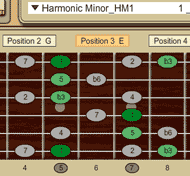
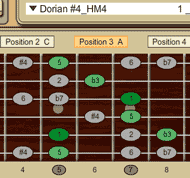
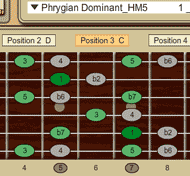
Minor Swing - Exercise for Harmonic Minor Scales
When you play scales, start or end your licks on chord notes.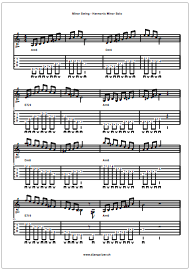
Attention:
When you compare an Am6 arpeggio with the HM1 scale, you can see, that the scale has a minor sixth, but the arpeggio has a major sixth. Actually, the Melodic Minor Scale (MM1) would fit better. Nevertheless, many musicians prefer to play the harmonic minor scale over a m6 chord.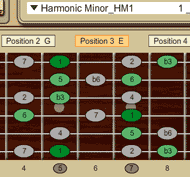
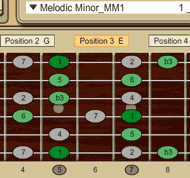
Check out by yourself, which scale you like more. It's a matter of taste.
Harmonic Minor Lick (HM5)
Here an example lick with for the HM5 scale over Minor Swing.Django played this lick over the last four bars of his solo from 1949.

Djangolizer Power-User
Practice the harmonic minor scale in different keys.Check it out in D minor songs like...
- "Dark Eyes"
- "Blue Drag"
- "Bossa Dorado"
or songs in G minor...
- "Douce Ambiance"
- "Minor Blues"
- "Swing Gitan"
Symetrical Scales
Symetrical scales are easy to memorize and easy to play as well. Their names point out, what notes you can play. One scale is called Halftone-Wholetone. Another one is called Wholetone.
Django used the Wholetone scale in the tune "Rythme
Futur".
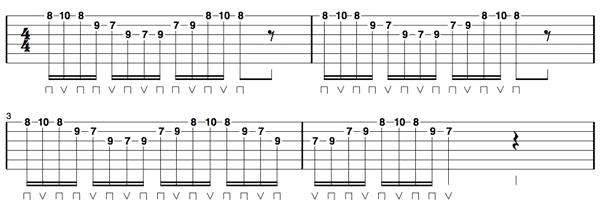

Bebop Scales
The Bebop scales are a new feature in Djangolizer version 1.8.The characteristic of all five Bebop scales are the 8 notes instead of 7. There is one chromatic note added.
There are two Bebop minor scales...
- One is for playing the 1st mode in a minor context.
- The other one is used for the 2nd mode in a major context. Useful over a 2 5 1 progression.



